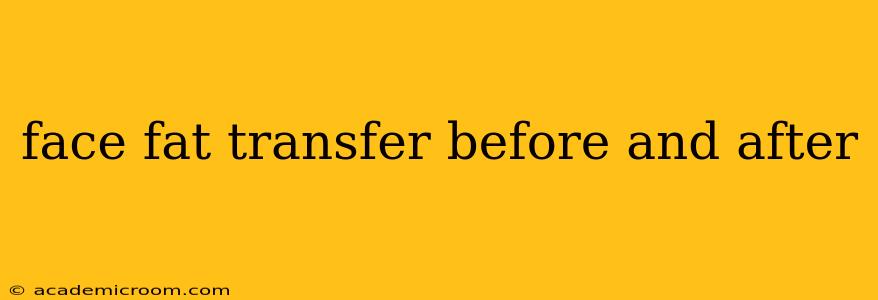Facial fat transfer, also known as autologous fat grafting, is a cosmetic procedure that involves harvesting fat from one area of the body and injecting it into the face to enhance volume, contour, and rejuvenate the appearance. This minimally invasive procedure offers a natural-looking alternative to fillers and other more extensive facial surgeries. But what can you expect before, during, and after the procedure? Let's explore.
What are the Benefits of a Face Fat Transfer?
A face fat transfer offers several advantages over other cosmetic treatments:
- Natural Results: Because the fat is harvested from your own body, the results look incredibly natural and integrate seamlessly with your existing facial features. There's minimal risk of an unnatural or artificial appearance.
- Volume Restoration: This procedure effectively addresses volume loss in the cheeks, temples, and other areas of the face, often associated with aging. It can restore a youthful, fuller appearance.
- Improved Skin Quality: The transferred fat can improve skin texture and hydration, leading to a smoother, more radiant complexion.
- Long-lasting Results: While the longevity varies depending on individual factors, fat transfer results can last significantly longer than temporary fillers. However, some absorption is expected.
- Minimally Invasive: Compared to more invasive surgical procedures, a fat transfer is less traumatic, with shorter recovery times.
What Does a Face Fat Transfer Procedure Entail?
The procedure generally involves three steps:
- Liposuction: Fat is gently suctioned from a donor area, typically the abdomen, thighs, or hips.
- Fat Processing: The harvested fat undergoes a purification process to remove excess fluids and impurities, resulting in a higher concentration of viable fat cells.
- Injection: The purified fat is carefully injected into the designated areas of the face using specialized cannulas.
What Should I Expect Before the Procedure?
Before your face fat transfer, a thorough consultation with a qualified plastic surgeon is crucial. This consultation will involve:
- Medical History Review: The surgeon will assess your overall health and medical history to ensure you are a suitable candidate.
- Facial Assessment: Your facial features and areas needing improvement will be carefully evaluated.
- Realistic Expectations: The surgeon will discuss realistic expectations and potential outcomes. It's important to understand that not all injected fat will survive.
- Pre-operative Instructions: You will receive detailed instructions regarding preparation for the procedure, including any dietary restrictions or medications to avoid.
What is the Recovery Like After a Face Fat Transfer?
Recovery time varies, but generally, you can expect:
- Swelling and Bruising: This is common and usually subsides within a few weeks.
- Numbness: Some numbness in the treated areas may persist for a few weeks.
- Discomfort: Mild discomfort can be managed with over-the-counter pain relievers.
- Follow-up Appointments: Follow-up appointments are necessary to monitor healing and assess the results.
How Long Do the Results of a Face Fat Transfer Last?
The longevity of the results depends on several factors, including the patient's age, overall health, lifestyle, and the body's natural absorption rate. While some fat absorption is expected, a significant portion of the transferred fat should remain, providing long-lasting volume enhancement. Many patients see results lasting several years or even longer.
What are the Risks and Potential Complications?
As with any surgical procedure, there are potential risks and complications associated with a face fat transfer. These may include:
- Infection: A small risk of infection exists, but proper sterile techniques minimize this.
- Swelling and Bruising: While common, excessive swelling or bruising may occur.
- Lumps or Irregularities: In some cases, lumps or irregularities may develop, requiring minor adjustments.
- Fat Necrosis: This is the death of fat cells and is relatively rare.
- Allergic Reactions: Although rare, allergic reactions to anesthesia or other materials are possible.
Can I Combine a Face Fat Transfer With Other Procedures?
Yes, a face fat transfer can often be combined with other cosmetic procedures, such as a facelift, brow lift, or eyelid surgery. This can provide a more comprehensive facial rejuvenation. Your surgeon will discuss the best approach based on your individual needs.
What is the Cost of a Face Fat Transfer?
The cost of a face fat transfer can vary considerably depending on factors such as the surgeon's fees, geographic location, the extent of the procedure, and any additional procedures. It's essential to discuss the total cost with your surgeon during your consultation.
Face Fat Transfer Before and After Photos: Are They Realistic?
Before and after photos are a valuable tool, but it's crucial to view them critically. Remember that individual results vary, and the photos may not accurately reflect your potential outcome. Discuss your expectations realistically with your surgeon. They will be able to show you photos of their own patients, offering a better gauge of what you might expect.
Is a Face Fat Transfer Right for Me?
This procedure is suitable for individuals who wish to restore facial volume, improve skin texture, and achieve a more youthful appearance. It's important to have realistic expectations and a candid conversation with a qualified plastic surgeon to determine if a face fat transfer is the right choice for you.
This information is for educational purposes only and should not be considered medical advice. Always consult with a qualified healthcare professional before undergoing any cosmetic procedure.
